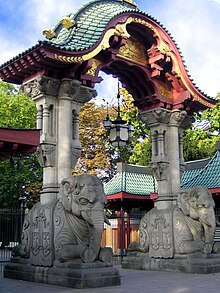Postaer sandstone



The Posta Sandstone , also Wehlener sandstone called, is a species of the Elbe Sandstone Rocks .
It only occurs on the right bank of the Elbe in the Alte Poste valley , near Herrenleithe , Wehlen , zeichen and Posta . The thickness of the deposit is 30 to 50 meters. The deposit is also known as the over- block , it has the smallest spatial extent of the Saxon sandstone deposits. The quarrying took place in 2008 in the vicinity of Lohmen and Wehlen .
Formation and nature of the rock
The Postaer sandstone originated in the chalk , in the lower Turon . This natural stone can be whitish or it is colored yellowish, yellowish gray and light yellowish to brown by limonite components . He is pebbly bound. The grain size is between 0.25 and 0.5 millimeters and the gaps are largely free of pelitic components (in contrast to the sandstone type Cotta ). It is known as medium-grain. Typical optical features are the flag-like bands of the iron minerals (limonite complex).
Its stratification only appears after it has been paved outdoors and has been weathered accordingly , because on freshly broken surfaces in the quarry the ashlar appears as unlayered. When installed outdoors, this sandstone darkens, like many yellow sandstones, to a black color. This is no damage, because the technical values do not change. It is related to the fact that the iron minerals contained in the stone are dissolved and their reaction products migrate to the stone surface. Microbial accompanying processes are not excluded. Under common environmental conditions, this leads to a black patina .
- Material properties
- Density approx. 2100 kg / m 3
- Compressive strength approx. 62 MPa (perpendicular to the layering)
- Water absorption approx. 5.9%
- Open porosity approx. 20.6%
Sandstone is frost-proof, but not resistant to de-icing salt .
Dismantling and use
The Postaer sandstone is mined in 2008 in two quarries (one in Wesenitztal near Lohmen) and it is used for massive window and door frames, facade panels, stone carving and profiled stone carving. It is mainly used for restoration and partly in new construction projects. A selection of the uses of the Postaer sandstone:
-
Berlin :
- Ground floor of the Technical University of Berlin in Charlottenburg
-
Dresden :
- Altmarkt (redevelopment after the Second World War)
- Bismarck Tower
- Dresdner bank building
- Anne's Church
- Eckberg Castle
- Dresden Central Station
- Coselpalais
- woman Church
- Dresdner Zwinger , Braun's studio
- Albrechtsberg Castle
- Hamburg :
-
Magdeburg :
- Old guard
- Potsdam
-
Senftenberg :
- War memorial for those killed in the First World War
- Art-historical use of Postaer Stein
See also
literature
- W. Dienemann and O. Burre: The usable rocks of Germany and their deposits with the exception of coal, ores and salts, Enke-Verlag, Stuttgart 1929, p. 304ff
- Siegfried Grunert: The Elbe sandstone: occurrence, use, properties . In: Geologica Saxonica Journal of Central European Geology 52/53 (2007), pp. 143–204 ( digitized version ; PDF; 609 kB)
Web links
- Technical data Postaer sandstone
- Information about the Elbe sandstone
- Laser cleaning of Postaer sandstone during restoration work
Individual evidence
- ↑ Dienemann / Burre: The usable rocks Germany , p 306
- ↑ Technical values of the Postaer sandstone ( Memento of the original from March 23, 2012 in the Internet Archive ) Info: The archive link was automatically inserted and not yet checked. Please check the original and archive link according to the instructions and then remove this notice.
- ↑ Dienemann / Burre: The usable rocks Germany , p 306
- ↑ Heiner Siedel / Jan-Michael Lange / Ferdinand Heinz: Building and decorative stones in Dresden . Dresden (Senckenberg NHSD) 2009, p. 23, ISSN 1860-3866
- ↑ https://www.sandsteine.de/sandsteinarten/postaer-sandstein/ Information from the company Sächsische Sandsteinwerke GmbH , accessed on July 14, 2020
- ↑ https://www.jonastone.de/w/platten/frostsicherheit-bei-naturstein.html Information from jonastone GmbH & Co. KG : Frost protection in natural stone , accessed on July 14, 2020




